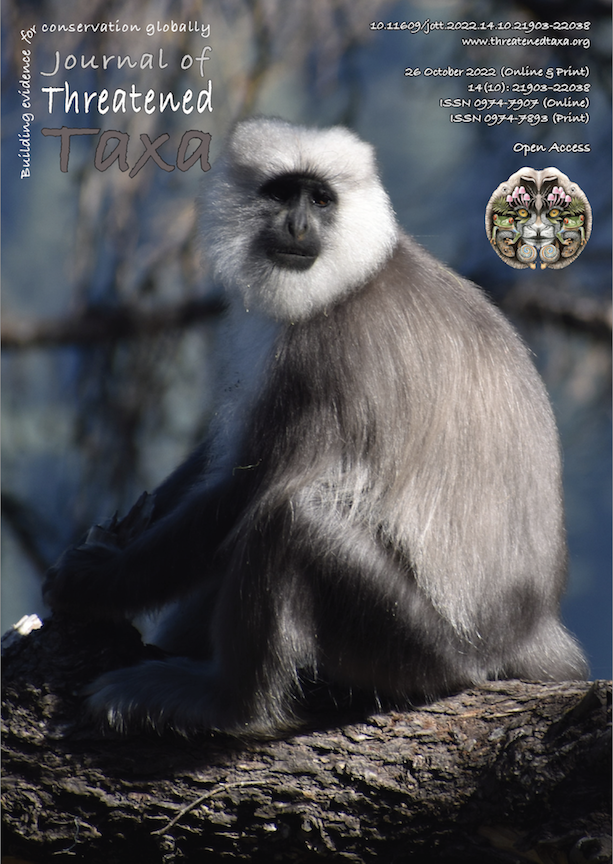Contribution to the moss flora of northern Sikkim, India
Main Article Content
Abstract
Study of species composition and community structure is an essential requirement for maintaining the ecosystem functions, conservation, and sustainable use. Bryophytes are integral components of biodiversity and resilient during perturbation. The present investigation was, therefore, a survey in North Sikkim district (India) to study the diversity and distribution of mosses resulting in a total of 113 species in 74 genera and 28 families as new records to the study area. Of these, 14 species are considered rare based on their frequency of occurrence. The family Meteoriaceae which consists of mainly epiphytic taxa is found to be dominant and widely spread in the study area followed by Pottiaceae, Leucobryaceae, and Dicranaceae families. Sixteen species are found to be remarkable in contributing major biomass to the forest floors and as epiphytes. Five species are recorded to be endemic to this area. Most of the epiphytic species are found to be abundant in the area, indicating the good health of ecosystem. The data would be useful in the planning of conservation and management of biodiversity.
Article Details

This work is licensed under a Creative Commons Attribution 4.0 International License.
Authors own the copyright to the articles published in JoTT. This is indicated explicitly in each publication. The authors grant permission to the publisher Wildlife Information Liaison Development (WILD) Society to publish the article in the Journal of Threatened Taxa. The authors recognize WILD as the original publisher, and to sell hard copies of the Journal and article to any buyer. JoTT is registered under the Creative Commons Attribution 4.0 International License (CC BY), which allows authors to retain copyright ownership. Under this license the authors allow anyone to download, cite, use the data, modify, reprint, copy and distribute provided the authors and source of publication are credited through appropriate citations (e.g., Son et al. (2016). Bats (Mammalia: Chiroptera) of the southeastern Truong Son Mountains, Quang Ngai Province, Vietnam. Journal of Threatened Taxa 8(7): 8953–8969. https://doi.org/10.11609/jott.2785.8.7.8953-8969). Users of the data do not require specific permission from the authors or the publisher.
References
Chopra, R.S. (1975). Taxonomy of Indian mosses (an introduction). Botanical Monograph [New Delhi] i-xl; 631 pp.
Dierick, D. & D. Hoelscher (2009). Species-specific tree water use characteristics in reforestation stands in the Philippines. Agricultural and Forest Meteorology 149(8): 1317–1326. DOI: https://doi.org/10.1016/j.agrformet.2009.03.003
Flora of North America Editorial Committee (Ed.) (2007). Flora of North America, North of Mexico. Bryophyta. Oxford University Press, Pt. 1 (27), 713 pp.
Gairola, S., R.S. Rawal, N.P. Todaria & A. Bhatt (2014). Population structure and regeneration patterns of tree species in climate-sensitive subalpine forests of Indian western Himalaya. Journal of Forestry Research 25(2): 343–349. DOI: https://doi.org/10.1007/s11676-014-0463-0
Gangulee, H.C. (1969–1980). Mosses of Eastern India and Adjacent Regions. Fascicle I. 1969, Fascicle. II. 1971, Fascicle. III. 1972, Fascicle. IV. 1974, Fascicle. V. 1975, Fascicle. VI. 1977, Fascicle. VII. 1978 and Fascicle. VIII. 1980. Eastend Printers, Calcutta, India .
Kimmerer, R.W. & C.C. Young (1996). Effect of gap size and regeneration niche on species coexistence in bryophyte communities. Bulletin of the Torrey Botanical Club 123(1): 16–24. DOI: https://doi.org/10.2307/2996302
Koponen, T. & Y. Sun (2017). Preliminary study on phylogenetic position and delimitation of the ciliate arthrodontous genera of the moss family Mniaceae. Journal of Bryology 39(1): 23–38. DOI: https://doi.org/10.1080/03736687.2016.1177160
Larsen, R.S., J.N.B. Bell, P.W. James, P.J. Chimonides, F.J. Rumsey, A. Tremper & O.W. Purvis (2007). Lichen and bryophyte distribution on oak in London in relation to air pollution and bark acidity. Environmental Pollution 146(2): 332–340. DOI: https://doi.org/10.1016/j.envpol.2006.03.033
Levin, S.A. (1992). The problem of pattern and scale in ecology: the Robert H. MacArthur award lecture. Ecology 73(6): 1943–1967. DOI: https://doi.org/10.2307/1941447
Muscolo, A., S. Bagnato, M. Sidari & R. Mercurio (2014). A review of the roles of forest canopy gaps. Journal of Forestry Research 25(4): 725–736. DOI: https://doi.org/10.1007/s11676-014-0521-7
Noble, I.R. & R. Dirzo (1997). Forests as human-dominated, ecosystems. Science 277(5325): 522–525. DOI: https://doi.org/10.1126/science.277.5325.522
Pradhan, B.K. & H.K. Badola (2008). Ethnomedicinal plant use by Lepcha tribe of Dzongu valley, bordering Khangchendzonga Biosphere Reserve, in North Sikkim, India. Ethnobiology. Ethnomedicine 4: 22. DOI: https://doi.org/10.1186/1746-4269-4-22
Rahman, H., R. Karuppaiyan, P.C. Senapati, S.V. Ngachan & A. Kumar (2012). An analysis of past three-decade weather phenomenon in the mid-hills of Sikkim and strategies for mitigating possible impact of climate change on agriculture. Climate Change in Sikkim: Patterns, Impacts and Initiatives, 1–18 pp.
Richards, P.W. (1984). The ecology of tropical forest bryophytes, pp. 1233–1270 In: Schuster, R.M. (ed.). New Manual of Bryology. Hattori Botanical Laboratory, Nichinan.
Sefidkon, F., R. Kalvandi, M. Atri & M.M. Barazandeh (2005). Essential oil variability of Thymus eriocalyx (Ronniger) Jalas. Flavour and Fragrance Journal 20(5): 521–524. https://doi.org/10.1002/ffj.1442 DOI: https://doi.org/10.1002/ffj.1442
Goffinet, B., W.R. Buck & A.J. Shaw (2009). Morphology, anatomy, and classification of the Bryophyta. Bryophyte Biology, 2nd Edition. Cambridge University Press, Cambridge.
Sikkim Biodiversity Action Plan (2012). Sikkim Biodiversity Conservation and Forest Management Project, FEWMD, Government of Sikkim, CONCEPT, India.
Singh, D. & D.K. Singh (2013). Some new and noteworthy records of family Lejeuneaceae (Marchantiophyta) from Sikkim, India. Nelumbo 55: 153–165.
Singh, D.K., D. Singh & M. Dey (2008). A catalogue of the Hepaticae and Anthocerotae of Sikkim, pp. 93–135. In: Mohamed, H., B.B. Baki, A. Nasrulhaq-Boyce & P.K.Y. Lee (eds.). Bryology in the New Millenium. University of Malaya, Kuala Lumpur.
Singh, D.K. & P.K. Pusalkar (2020). Floristic Diversity of the Indian Himalaya. In: Dar, G. & A. Khuroo (eds). Biodiversity of the Himalaya: Jammu and Kashmir State. Topics in Biodiversity and Conservation. Springer, Singapore, 1097 pp. DOI: https://doi.org/10.1007/978-981-32-9174-4_5
Whitmore, T.C. (1984). A vegetation map of Malesia at scale 1: 5 million. Journal of Biogeography 11: 461–471. DOI: https://doi.org/10.2307/2844792

